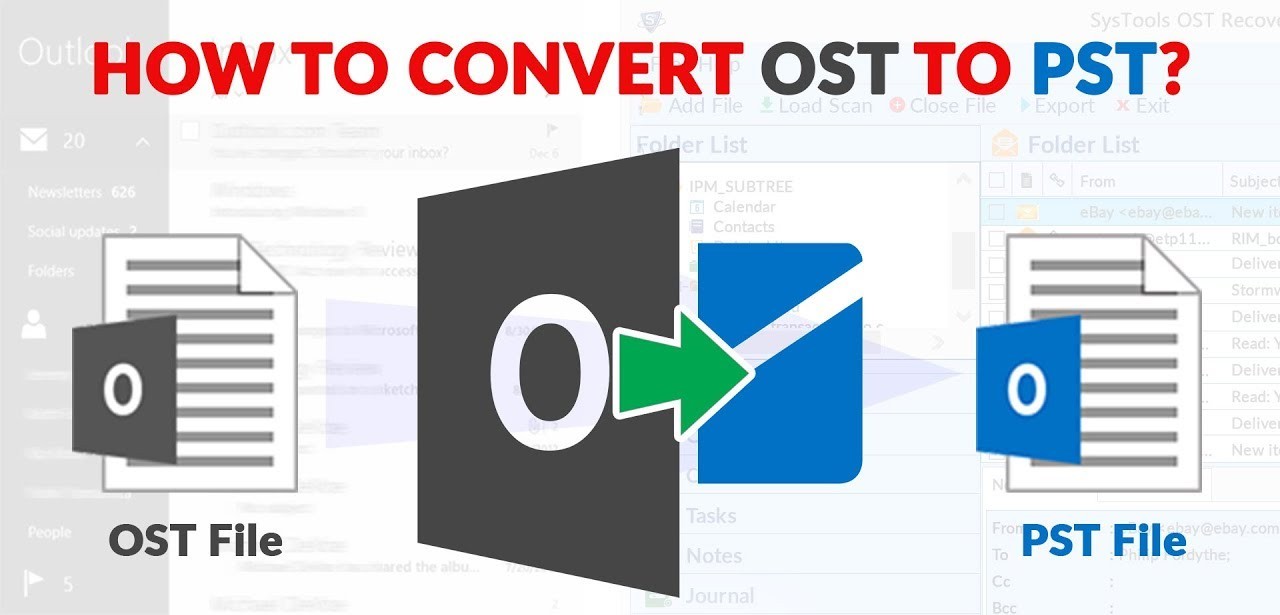![]()
The Offline Storage Table (OST) is an Outlook data file that stores mailbox data such as emails, contacts, attachments, and other items. When the server or the internet is unavailable, it allows access to Outlook mail items. You must convert an OST file to Outlook importable PST format if you want to backup or migrate mail items from an OST file to another Outlook profile, live Exchange, or Office 365. When an OST file becomes orphaned or inaccessible, it must be converted to a PST file. We’ve covered how to convert OST to PST manually in this post, as well as a specialized tool that can convert inaccessible or orphaned OST files to PST.
When there is no internet connection, insufficient connectivity, or the Exchange server is inaccessible, Outlook users can operate in offline mode using OST. It’s a Microsoft Exchange mailbox cache that keeps emails, contacts, attachments, calendar items, notes, and so on.
Other article you might like: What is Tableau and Its Uses and Features
As soon as the system is connected to the internet, changes made in Outlook are saved in the OST file and synchronized automatically to the mailbox on the Exchange server.
The Offline Outlook OST file, on the other hand, is encrypted with the MAPIEntryID GUID key, and access to the mail items requires authentication from the attached MAPI profile.
The related OST file becomes orphaned and unavailable if the user profile is removed or deleted from the server or Outlook. Unlike PST, there is no way to import or open an OST file into an Outlook profile. As a result, you’ll need to use OST to PST Converter an Outlook-compatible format.
Converting an OST file to a PST file may be necessary in a variety of additional situations, including:
Exchange server crush: You will not be able to connect to the Exchange Server if Microsoft Exchange Server crashes or if there is a system failure for any reason. These kind of scenarios can have an influence on your work/business, and your Outlook profile may not function properly as a result. To access the data in such cases, you must convert the OST file to PST.
Exchange Server account deletion by accident: If your Exchange Server account is mistakenly deleted or data is lost, you can easily restore it by converting the OST file to PST format.
Data Migration: Converting OST to PST allows you to seamlessly relocate data from one system to another. This is advantageous for enterprises that require data transfer between machines.
Exchange Server maintenance: When Exchange Server is down for maintenance, it’s critical to have access to all of your mailbox items. This is crucial because downtime might be prolonged and have a negative impact on your organization. Converting OST to PST is an effective solution in these instances.
Rebuild OST file: Let’s say you wish to rebuild your OST file, but it contains unsaved data. You’ll need to convert OST to PST in that instance.
Manual OST to PST Conversion Methods
There are three distinct ways to manually convert an OST file to a PST file.
Use the Outlook Import Export Wizard to import and export data from Outlook.
The procedures to convert an OST file to a PST file using the Outlook Import Export wizard are listed below.
Note: This strategy only works if Outlook and OST are both connected to the same Exchange Server mailbox.
- To begin, open Microsoft Outlook and select File > Open & Export from the File menu.
- From the drop-down menu, choose “Import/Export.”
- You will be prompted to “Choose an action to execute” in a new dialogue box. Click on ” export to file” and then on “Next” to proceed.
- You’ll be asked to choose a file type to import on the next screen. To continue, select “Outlook Data File (.pst)” and click the “Next” button.
- Now select the folder from which you want to export. To proceed, choose the files you want to export and then click the “Next” button.
- Select “Allow duplicates to be made” from the drop-down menu, then click the “Finish” button.
- After that, you’ll be prompted to provide an optional password in a new pop-up. You can go ahead and click the “OK” button without supplying it, and your OST file will be automatically saved in PST format at the specified location.
For The Conversion, use “Archive.”
Note: To save mail items from an OST file to a PST file, you must enable the Archive Settings. It also maintains a healthy mailbox size by keeping older emails in the archive folder.
To create an archive mailbox, follow the steps below:
- To begin, open Microsoft Outlook and select “File Menu” from the upper left corner of the screen.
- Navigate to “Advanced” after clicking “Options.”
- On the screen, click the “Auto Archive Settings” button.
- Now enter the number of days you want the Auto Archive to run for. Then, using the “Browse” option, save the archive file to the specified destination. Then press the “OK” button to proceed.
- The process will begin, and the mailbox items will be automatically saved to the PST file.
To A New PST File, Drag And Drop
- To begin, start by opening Microsoft Outlook and creating a new PST file for your Outlook profile.
- To do so, go to the Toolbar and select “New Items.” Select “More Items” -> “Outlook Data File” from the drop-down menu.
- You can provide a password in the optional password field along with the file name.
- The PST file is created once you click the OK button.
Drag and drop the mailbox folders you want to export to the freshly produced PST file into a mail folder in the new PST file.
Note: The Inbox and Contacts folders will not be able to be dragged to the PST file. You’ll need to copy the folder from OST to PST for this.
Manual Methods Have Limitations
The manual techniques for converting OST to PST have a number of disadvantages, including:
- They take a long time to complete and demand a lot of effort.
- They carry the danger of data loss.
- There is a possibility of human error.
- When the Outlook profile is erased from the mailbox server, it stops working.
- When the OST is orphaned or inaccessible, it won’t work.
[Recommended] Use OST to PST Converter Software
It is advisable to use an OST to PST converter software, such as Stellar Converter for OST, to address the disadvantages of manual techniques.
SysTools software for Conversion is a powerful OST to PST converter that makes the process of converting OST files to PST files swift and painless, with no risk of human error. This utility converts an OST file to a PST file by extracting all mailbox information. During the conversion process, the mailbox hierarchy is kept, and no data is lost. It can also directly export the OST to an existing Outlook profile, Office 365, or Live Exchange Server.
It can convert encrypted OSTs and IMAP OST files with no file size restrictions. It offers a free enhanced viewing of emails, calendars, and other mailbox items to assist you in rapidly finding and restoring critical correspondence. The best thing is that it will convert OST to PST files for free for the first 10 emails in each folder.
To Summarize
Due to an Exchange Server breakdown or unanticipated downtime, the OST to PST conversion can assist avoid workplace disruptions and productivity.
There are a few manual techniques for converting OST to PST that, while not expensive, come with some drawbacks. If you’re using Microsoft Outlook with your original Exchange account, for example, you can only convert OST to PST manually. Also, because these manual procedures take longer to convert the OSTs, they aren’t suitable for large-scale conversions.
Due to faster execution, complete capabilities (multi-format output, batch conversion, etc.), and a more seamless overall experience, a software-based solution is more effective for converting single or numerous OSTs to PSTs. You can also immediately export the OST to PST format. The software can also be downloaded and evaluated for free.




